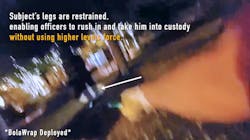That’s a Wrap: The BolaWrap is Helping Officers Detain Suspects
In law enforcement, technology continues to evolve. Tools like EMDs, body cameras and unmanned aerial vehicles (drones) have changed the way officers perform their jobs. As with all technology, many ideas take time to get footing, but the best executed ones often prevail.
When the BolaWrap from Arizona-based Wrap Technologies jumped on the scene back in 2018, it got a lot of sideways looks at first. The remote restraint tool discharges a Kevlar cord to help detain an uncooperative subject from a distance. The visual can be jarring at first as the hand-held device creates a lasso-like effect around the subject’s torso or legs, rendering them stationary.
Over the last four years, the device has proven itself time and again as agencies around the country have begun using the tool and sharing their results captured on video. Here are several recent cases in which the BolaWrap helped officers de-escalate a situation that could have otherwise gone off the rails:
Glenwood Springs
On Dec. 22, 2021, a business owner in Glenwood Springs, Colorado, reported to police that there was a man was smashing holiday displays and pulling down lights in the city’s downtown area. Police Chief Joseph Dera says that his officers were familiar with the subject involved and responded to the scene.
On the body camera video , an officer can be heard telling the subject, “Stop! Stop, or you’re going to get restrained.” The subject then responds: “I need help.” The officer tells the subject, “OK, I am trying to get you help. What’s going on?”
Ultimately, the officers made the determination that they were going to detain the man for a criminal violation, but he was still uncooperative. “We encourage (our officers) to use the BolaWrap early and often after contact so we don’t have to use higher applications of force, and that’s exactly what you see in the video,” says Dera. “There is a wonton disregard for command and a willful resistance. They deployed that BolaWrap to stop his forward movement… The second officer felt that he was going to reach down and try to pull it off. That’s when they immediately deployed the second BolaWrap to the upper body and wrist and forearm area.”
The device wrapped up the suspect and the officers were able to take control of him and take him into custody safely. Prior to the officers deploying the BolaWrap, Dera says the man told them that he wanted to be shot immediately. “Having this technology available to them really minimized their exposure to injury to them and of course to the suspect, which is always a benefit for everybody involved.”In a separate incident on Sept. 29, 2021, officers were out on patrol on the graveyard shift, and they were aware of an individual who was wanted on outstanding arrest warrants and saw him in the downtown area. When they tried to find him, he eluded them initially and they were able to locate him at a small park a short time later. “They have had previous contacts with this gentleman, so they know a little bit about him and how he reacts to his contacts with law enforcement,” says Dera. “Generally, in the past, he’s just been cantankerous with our officers and visitors to our community. He’s just not real cooperative in general.”
When they contacted him, they told him there were warrants out for his arrest. He told the officers “I’m not going to jail tonight.” He then turned his back and started to walk away from the officers. The BolaWrap was deployed, wrapping around his lower legs. “He hears that loud sound go off and that distracts him, he turns around right away and feels the pressure to his lower body,” says Dera. “The officers put their hands on him. At that point you hear him say ‘OK, OK, I’ll go with you.’ ”
The man’s attitude completely changes once the device contained him and officers were able to detain him.
“The bottom line here is that we took somebody into custody without having to use higher levels of force, subject our officers and the individual to any kind of injury and we were able to safely walk him down the street and put him into a police car on his way to jail,” says Dera.Indianapolis
On Oct. 24, 2021, Indianapolis Metro Police Department officers responded to reports of a man laying in the street calling for help. They located an individual in the street who they believed was under the influence of narcotics due to his extremely erratic behavior.
“His body was flailing in all kinds of different directions,” says Officer Vincent Marshall. “Previously we probably could have just sent in multiple officers and grabbed a hold of him and just manhandled him into handcuffs, but we all thought this was a prefect training opportunity to utilize the BolaWrap.”
Marshall deployed the device, wrapping up the man’s legs and allowing officers to take him into custody. It was his first time using the BolaWrap. “It was just like training. Thankfully we were ready for it and having that time made it very easy to use and it was very effective,” he says. “I think the most valuable part of it was the distraction technique that snapped him out of his drug craze for about five minutes, long enough to realize something was happening. He didn’t resist and the officers were able to get him into handcuffs without further issue. He was really never combative, but the potential was always there.”
Auburn
On Sept. 6, 2021, Auburn Police Department in Washington responded to a violent subject who had thrown a bottle at another individual’s car and had threatened to “beat him.” Commander Cristian Adams says that the officers had probable cause to arrest the man for malicious mischief and that he wasn’t far from the police station when contact was made.
“One of the officers there is one of our trained BolaWrap instructors,” he says. “The officers on the scene made the plan to use the BolaWrap. You can hear the officer give a ‘Bola’ warning before deploying the BolaWrap at the waist of the individual. The individual is hit in the thigh area and in the video, you can see he tried to take a step and then stops, looking down at the BolaWrap to figure out what’s going on.”
The use of the device gave officers the time and opportunity to move in quickly and place the man in handcuffs without anyone being injured.According to Adams, the state of Washington had made a recent legislative update that required officers to de-escalate before using force and also to use less-lethal tools or options before using physical force to make an arrest. “It’s great to have a tool that limits or restricts movement that allows us to move in, especially while their attention is diverted because they heard a bang, they felt something wrap them, and they’re trying to figure out what’s going on.” he says. “By the time they do, we’re already there putting them in handcuffs without any use of pain compliance, strikes, or any other tools. They had other tools available, such as a blue nose, rubber bullets, and TASERs, but they chose to go with the least intrusive tool, and that was the BolaWrap. It was able to get the desired effect that we wanted—no injuries and one person into custody going to the hospital to seek treatment.”
About the Author
Paul Peluso
Editor
Paul Peluso is the Managing Editor of OFFICER Magazine and has been with the Officer Media Group since 2006. He began as an Associate Editor, writing and editing content for Officer.com. Previously, Paul worked as a reporter for several newspapers in the suburbs of Baltimore, MD.




